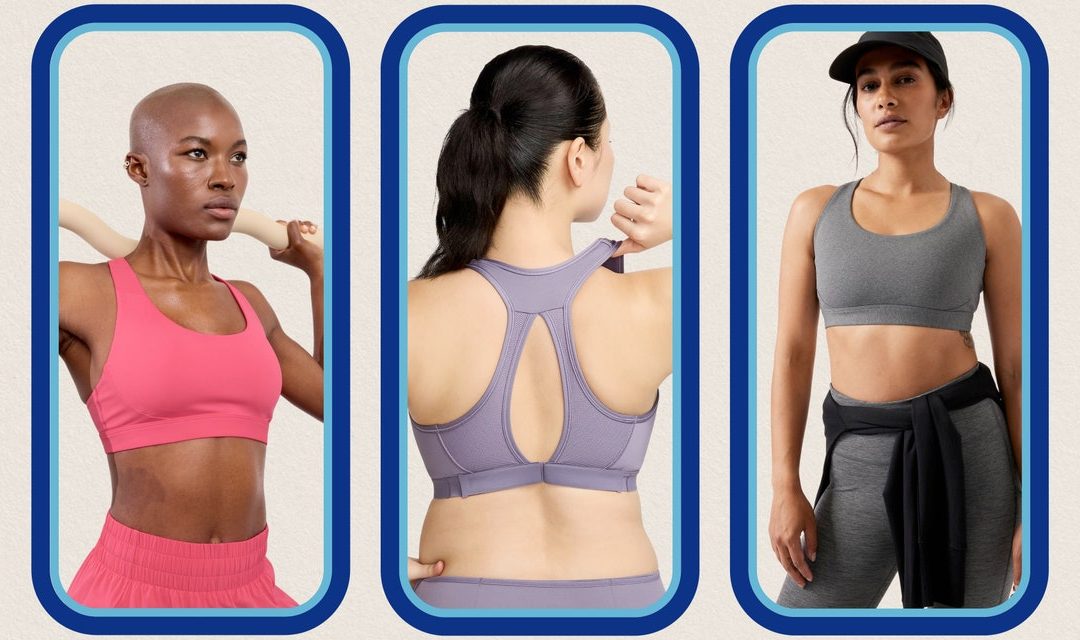And here’s one more feature that helps ensure consistent coverage: The bra’s padding is removable, but if you decide to keep it, you don’t have to worry about it shifting around in the middle of your run. The padding features little grippy dots to help it stay put (genius).
Product specs
Sizes: XXS to XXL (A/C to D/DD cups) | Material: Polyester, elastane
More great options
If you’re running, jumping, and breaking a sweat on a regular basis, it can’t hurt to have a few more sports bras handy—here are some more top-notch options to add to your collection.
Panache Non Wired Sports Bra
Panache
Non Wired Sports Bra
With its wide, adjustable straps and built-in, molded cups, this top-rated sports bra from Panache is made to hold you up and in. Its compression is balanced out by a good amount of stretch—reviewers say it feels sturdy yet flexible, which we’d consider the best of both worlds.
Product specs
Sizes: Band size 28 to 40, cup size B to J (UK sizes)| Material: Nylon, polyester, elastane
Oiselle Flyout Bra
Our director of fitness and food ran her first marathon in this Oiselle bra and came back with great things to say, specifically about the roomy back pocket: “My larger-than-average Android phone fit perfectly and securely in the pocket, and I didn’t feel it jostle. In fact, I didn’t feel it at all.”
Product specs
Sizes: 2 to 14 | Material: Polyester, Lycra
Why is it important to wear a supportive sports bra during high-impact activities?
Besides feeling comfortable (and avoiding a black eye), there are quite a few expert-backed reasons to wear supportive bras during runs or other high-impact workouts.
For one thing, your form changes if your chest isn’t well-supported, Lindsay Nunamacher, PT, DPT, a physical therapist at Hartford HealthCare, tells SELF. Running and jumping can cause your breasts to swing from side to side or bounce up and down. If you aren’t wearing anything that can help distribute the weight of your breasts and reduce this movement, you’re more likely to change how you work out. Your pace might slow, your strides might shorten, or your posture might tip forward. “These mechanical changes can negatively affect [your] performance,” Dr. Nunamacher says.
Wearing bras that lack support may also contribute to back and neck pain, Dr. Nunamacher says. Too much breast movement strains the rest of your upper body, which can cause your muscles to feel tired and sore more easily. Over time, your back may round and your head and neck may shift forward to compensate for that discomfort, she explains. And slouching isn’t just bad for these areas—as SELF has previously reported, it can create aches throughout your entire body.
So for your short- and long-term comfort, it’s worth your while to spend some extra time browsing bras: “A good sports bra allows you to focus on your workout and continue your journey towards your own fitness and health goals without distraction,” Dr. Nunamacher says.
What to look for when shopping for running sports bras
You probably already have some preferences when it comes to sports bras—maybe you like a zip-front closure or specific color combinations. In addition to those personal must-haves, here are other features you should keep in mind as you shop.
- Fit: Your bra should suit your measurements and cup size. Its fit should also provide some compression, NASM-certified Peloton Tread instructor Marcel Dinkins, CSCS, tells SELF. That’ll help hold your breasts in and limit their motion (but you should still be able to move and breathe comfortably). She adds that those with larger busts—think DD cups and above—should specifically look for encapsulation bras, or ones with built-in, structured cups.
- Fabric: Running bras should be built for sweat. Look for moisture-wicking, quick-drying materials like mesh and nylon, as well as breathable inserts or panels. Your bra should also feel smooth and comfortable when you’re working out (read: it shouldn’t chafe or rub against your skin). Seamless or flat-seamed designs are less likely to cause irritation, Dr. Nunamacher says.
- Straps: We’ve already mentioned that a high-quality sports bra will help distribute the weight of your breasts—this mostly comes down to the design of its shoulder straps. They should be wide, adjustable, and, for bonus points, padded. Skip skinny or trendy strap configurations like halters or one-shoulder necklines, Hayley Akradi, CPT, classes operations manager and national ultra fit program lead at Life Time, tells SELF. They’re cute for low-impact workouts, but they won’t provide you with the amount of support you need during runs—and, Dr. Nunamacher points out that they can dig into and pull on your shoulders, neck, and traps (ouch).
- Coverage: A little additional coverage can help you feel more secure as you run. Dinkins recommends looking for higher-cut necklines and avoiding scoop neck sports bras.
- Band: Think of the band as the foundation of your bra’s support system: You want it to be sturdy and snug. Akradi looks for bras with bands that fit firmly under her bust, and Dinkins prioritizes thicker, wider bands—ideally, your bra will check all of these boxes.
Get more of SELF’s great product recommendations delivered right to your inbox (for free!).
Related:
